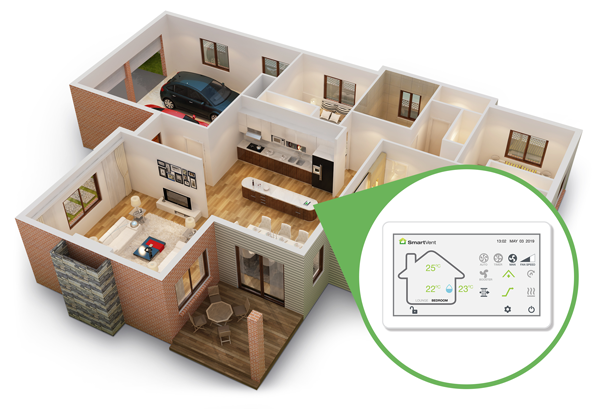Home Ventilation
Choose the Best Type of Ventilation System available in NZ
Ventilation in your home is important to maintain air quality and remove moisture. A dry home is generally a warmer and therefore healthier home. As new homes become more airtight the need to add a ventilation system is much greater. So, let’s look at the types of ventilation system most commonly available in New Zealand and what they’re best used for.
Looking for Ventilation for your business? Find out more here.


Positive pressure ventilation systems
These are very common in NZ in existing homes but do not comply with current ventilation standards for new builds. Essentially the system works by taking air from the attic or roof space and pumping it into the main living areas though ducts or vents. The air is trapped at this point and relies on gaps in the building structure to allow it to move. The other downside of these older systems is that they don’t have a heat exchanger like new systems do so they’re not designed to recover heat energy to help pre-warm incoming air.
Balanced pressure heat recovery systems
With newer systems it’s a two-way operation, fresh air comes in and old air is pushed out. It’s also fitted with a heat exchanger that recovers heat energy from the outgoing air and uses it to warm up the incoming air. This system is specifically designed for modern homes with fairly airtight construction and they work best with outlets in multiple rooms so air can flow through the whole house. The performance is also affected by the temperature difference between air inside and out. The larger the difference, the more heat the heat exchanger will recover so if you live in a colder part of the country, you’ll see better power bill savings than warmer regions.
Why is outside air better?
It’s MUCH fresher than the air that’s been circulating your house already. Add to that the fact that air from the roof or attic space will be significantly less fresh again. And because there is so little air movement in that part of a home the build-up of dust, dirt, mould and insect and rodent droppings makes this air dirty and difficult to clean by just filtering it.
Extractor fans and rangehoods
Bathrooms and kitchens generate huge amounts of moisture so a little extra help to get air moving in these rooms is needed. Extractor fans and rangehoods should be placed as close to the moisture source as possible and must be vented to the outside NOT the roof space. And because they only suck air out, think about having vents installed across the room from it or slightly opening a door or window in a nearby (but not too close) part of the home to get air moving.


HRV, ERV, HVAC – what’s the difference?
HRV stands for ‘heat recovery ventilation’ and it provides good climate control economically. However, they are mainly just for ventilation. No heating is added so it won’t warm your home (beyond what can be recovered by the heat exchanger). These are one of the best options for Kiwi homes.
ERV stands for ‘energy recovery ventilation.’ Effectively it works the same as an HRV system but an ERV transfers both temperature and moisture and uses its heat exchanger to pre-warm the cold air coming in. ERV systems aren’t great in NZ as we have naturally high occurring humidity. ERVs are best for increasing humidity in areas where it is uncomfortably low.
HVAC stands for Heating, Ventilation and Air Conditioning and is much more complicated than the others. Designing an HVAC system design takes mechanical engineering expertise and a grasp of the principles of thermodynamics, fluid mechanics, and heat transfer. HVAC systems are best for offices or large industrial spaces.
Is a heat transfer system also a ventilation system?
While some ventilation systems are combined with heat transfer systems these days, a heat transfer system on its own simply moves around air and heat that’s already in the home, blowing it through ducts or vents. It does not bring new air in and you need to have powerful heat source to make it worthwhile. A heat transfer system is great paired with a wood burner as they generate more heat than is needed for one room.
Choosing a ventilation system
If you’re sick of stale air and weeping windows, but don’t know where to start, we’re here to help. Here’s some helpful information for you to consider, or contact us and we can discuss the best ventilation system for your home.
- Sort out heating and insulation: You should only opt for a ventilation system if you’ve installed floor and ceiling insulation (if possible) as well as a decent heat source. In living areas this should be a fixed, efficient source of warmth, such as a heat pump or wood burner. In smaller rooms, portable plug-in electric heaters are sufficient.
- Tackle moisture at the source: Identify any sources of airborne moisture, such as bathrooms, then consider installing a shower dome or extractor fan. Also look at fitting a plastic moisture control sheet to stop rising damp, and check if water is pooling under the home from any blocked drains.
- Time for a dedicated ventilation system? If problems persist, you can opt for a mechanical ventilation system,
- Positive or balanced pressure? The first thing to consider when looking at ventilation systems is whether you should go for positive pressure or balanced pressure – don’t confuse either with heat transfer systems.
- Positive pressure (also known as forced air) ventilation systems work by blowing drier air into your house from the roof space above the ceiling or, in some types, from outside. They suit older houses with wooden joinery better than modern houses with sealed aluminium joinery (unless windows are opened or additional vents fitted). But blowing cold air in from the roof space in winter will require you to ramp up your heating.
- Balanced pressure (also known as heat exchanger) ventilation systems extract warm, damp air from living spaces and pass it through a heat-exchanger to heat up dry air, which the system brings in from outside. This can fully meet Building Code requirements. They work best in modern homes and don’t have the same unintended cooling effect as positive pressure systems, so choose a balanced pressure system if your home is well-sealed.
- Heat transfer systems aren’t ventilation systems, they simply haul warm air from one room to another (usually from a living area to bedrooms, etc.), but you can add a heat transfer system on to some ducted ventilation systems.
- Reliability: Nearly 90% of respondents who owned these brands said their system had never needed repair. The reliability of MoistureMASTER and SmartVent systems was below average at about 90%. These were the only 4 brands with sufficient respondents for us to comment on their reliability and satisfaction.
- Filters: Ventilation systems filter the air coming from your roof space or the outdoors. There are a wide array of filter types, usually designated by a letter and a number (for example, G4). In general, “F” filters remove smaller particles than “G” filters, so will catch more dust and airborne bacteria. The higher the second number, the more effective the filter – for example, an F7 filter will catch more nasties than an F6 filter. Some manufacturers offer optional advanced filters: carbon filters can be good for removing odours from the air (for example, the smell of everyone blasting their wood burner on a cold winter day), while HEPA filters are claimed to be effective at removing allergens. We recommend going for the standard filter initially, and only adding a carbon or HEPA filter if you find you’re dealing with odours indoors or suffering from allergies.
- Optional heaters / summer cooling: Some systems offer the ability to add heaters to ducting, which can be useful for positive pressure systems if you’re concerned about cool air from the roof space reducing indoor temperatures. Summer cooling options, where the ventilation system introduces cooler air to the home, are available but can be expensive.
Contact Us
To find out more about Ventilation and a solution for your home, or to receive a free estimate, call Citi Heat & Cool today – 03 547 3163
Or simply fill out the enquiry form below and we’ll be in contact soon.
